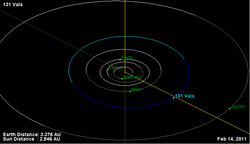Astronomy:131 Vala
 Orbital diagram | |
| Discovery[1] | |
|---|---|
| Discovered by | Christian Heinrich Friedrich Peters |
| Discovery date | 24 May 1873 |
| Designations | |
| (131) Vala | |
| Pronunciation | /ˈvɑːlə/[2] |
| Named after | vǫlva |
| A873 KA; 1945 KA; 1952 DS3; 1953 QE | |
| Minor planet category | Main belt[1] |
| Orbital characteristics[1] | |
| Epoch 31 July 2016 (JD 2457600.5) | |
| Uncertainty parameter 0 | |
| Observation arc | 142.88 yr (52187 d) |
| |{{{apsis}}}|helion}} | 2.60 astronomical unit|AU (388.64 Gm) |
| |{{{apsis}}}|helion}} | 2.27 AU (338.99 Gm) |
| 2.43 AU (363.82 Gm) | |
| Eccentricity | 0.068233 |
| Orbital period | 3.79 yr (1,385.3 d) |
| Average Orbital speed | 19.08 km/s |
| Mean anomaly | 289.275° |
| Mean motion | 0° 15m 35.532s / day |
| Inclination | 4.9602° |
| Longitude of ascending node | 65.682° |
| 160.641° | |
| Earth MOID | 1.26 AU (187.95 Gm) |
| Jupiter MOID | 2.38 AU (355.52 Gm) |
| TJupiter | 3.499 |
| Physical characteristics | |
| Dimensions | 40.44±1.8 km[1] |
| Mass | 6.9×1016 kg |
Equatorial surface gravity | 0.0113 m/s² |
Equatorial escape velocity | 0.0214 km/s |
| Rotation period | 5.1812 h (0.21588 d)[1] |
| Geometric albedo | 0.1051±0.010 |
| Physics | ~178 K |
| K[3] (Bus) | |
| Absolute magnitude (H) | 10.03[1] |
Vala (minor planet designation: 131 Vala) is an inner main-belt asteroid. It was discovered by C. H. F. Peters on 24 May 1873, and derives its name from völva (vǫlva, lit. staff bearer), a prophetess in Norse paganism.[4] One observation of an occultation of a star by Vala is from Italy (26 May 2002). 10-μm radiometric data collected from Kitt Peak in 1975 gave a diameter estimate of 34 km.[5]
In the Tholen classification system, it is categorized as an SU-type asteroid, while the Bus asteroid taxonomy system lists it as a K-type asteroid.[3] Photometric observations of this asteroid during 2007 at the Organ Mesa Observatory in Las Cruces, New Mexico were used to create a "nearly symmetric bimodal" light curve plot. This showed a rotation period of 10.359 ± 0.001 hours and a brightness variation of 0.09 ± 0.02 magnitude during each cycle.[6] The result is double the 5.18-hour period reported in the JPL Small-Body Database.[1]
On 2028-Apr-05, Vala will pass 0.0276 astronomical unit|AU (4,130,000 km; 2,570,000 mi) from asteroid 2 Pallas.[7]
References
- ↑ Jump up to: 1.0 1.1 1.2 1.3 1.4 1.5 1.6 "JPL Small-Body Database Browser: 131 Vala". Jet Propulsion Laboratory. https://ssd.jpl.nasa.gov/sbdb.cgi?sstr=131. Retrieved 12 May 2016.
- ↑ "Vala". Dictionary.com Unabridged. Random House. https://www.dictionary.com/browse/Vala.
- ↑ Jump up to: 3.0 3.1 DeMeo, Francesca E. et al. (July 2009), "An extension of the Bus asteroid taxonomy into the near-infrared", Icarus 202 (1): pp. 160–180, doi:10.1016/j.icarus.2009.02.005, Bibcode: 2009Icar..202..160D, archived from the original on 2014-03-17, https://web.archive.org/web/20140317200310/https://www.tara.tcd.ie/bitstream/2262/43276/1/PEER_stage2_10.1016/j.icarus.2009.02.005.pdf, retrieved 2013-04-08. See appendix A.
- ↑ Schmadel, Lutz D.; International Astronomical Union (2003). Dictionary of minor planet names. Berlin; New York: Springer-Verlag. p. 27. ISBN 978-3-540-00238-3. https://books.google.com/books?id=KWrB1jPCa8AC&pg=PA27.
- ↑ Morrison, D.; Chapman, C. R. (March 1976), "Radiometric diameters for an additional 22 asteroids", Astrophysical Journal 204: pp. 934–939, doi:10.1142/9789812834300_0469, Bibcode: 2008mgm..conf.2594S.
- ↑ Pilcher, Frederick (June 2008), "Period Determination for 84 Klio, 98 Ianthe, 102 Miriam 112 Iphigenia, 131 Vala, and 650 Amalasuntha", The Minor Planet Bulletin 35 (2): pp. 71–72, doi:10.1016/j.pss.2012.03.009, Bibcode: 2008MPBu...35...71P.
- ↑ "JPL Close-Approach Data: 131 Vala". https://ssd.jpl.nasa.gov/sbdb.cgi?sstr=131;cad=1#cad. Retrieved 2011-12-07.
Further reading
- Franco, Lorenzo et al. (October 2019), "Spin-Shape Model for 131 Vala", Bulletin of the Minor Planets Section of the Association of Lunar and Planetary Observers 46 (4): 392–394, Bibcode: 2019MPBu...46..392F
External links
- 131 Vala at AstDyS-2, Asteroids—Dynamic Site
- 131 Vala at the JPL Small-Body Database
 |

